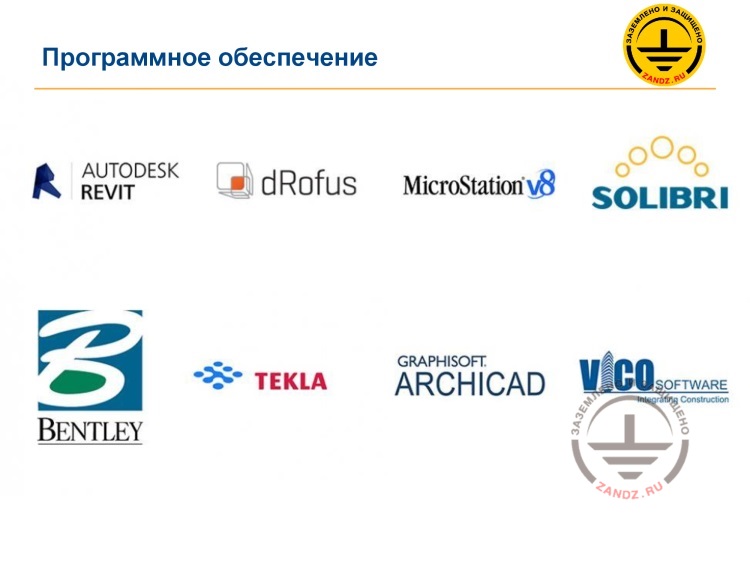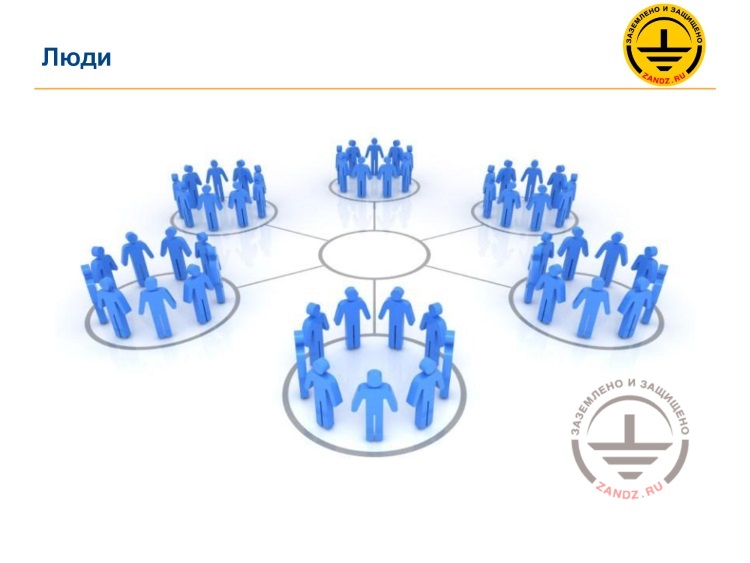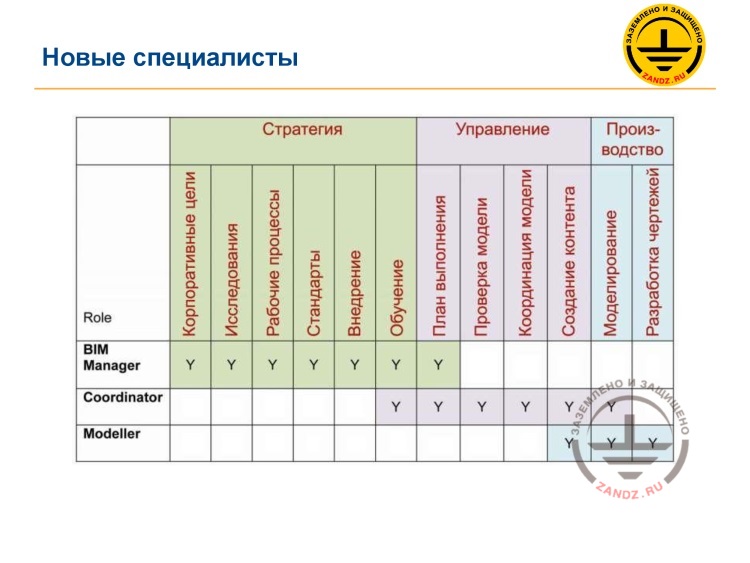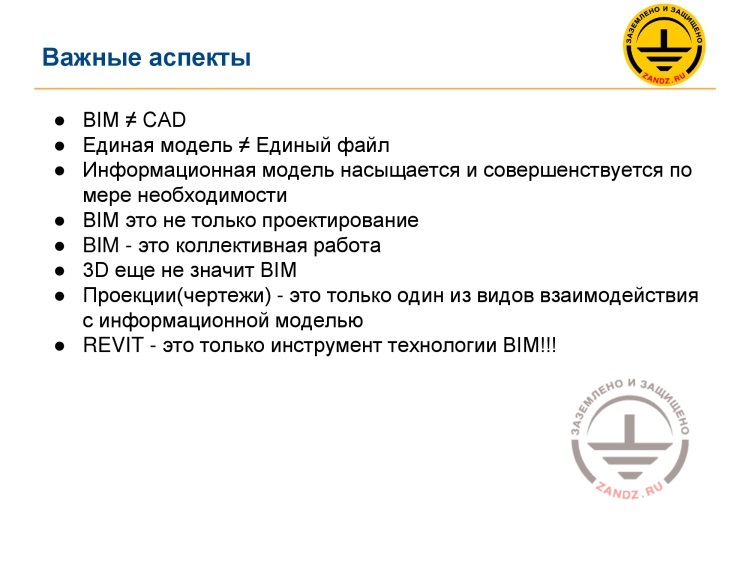Webinar text. Page 3
Fast navigation by slides:
Page 3:
15. Software
16. People
17. New specialists
18. Important aspects
19. Contacts
20. Questions and answers
Software
Программное обеспечение - Software
– Technologies also imply some software, i.e. many various software suites. It means more than one hundred of them. There are many organizations that develop the software for information modelling. Some of them are shown in this slide. We can see Autodesk Revit in the corner. It is the application that is widely known today among the software associated with the information modelling. But this is not the only one; there are many of them. Very often, you could hear of ARCHICAD available from GRAPHISOFT. I think that 10 years ago, when the architects worked in this software, they did not understand that they worked in the information modelling software, because nobody knew what it was at that time. Everybody knew what ARCHICAD was, that you can build 3D buildings there and thus produce the detailed design documents faster than in case of using AutoCAD and 2D drawings. But this is the same information modelling technology implying the same processes. Along with AutoCAD and GRAPHISOFT, there is also, e.g., Bentley providing its own product, MicroStation, that works in the same way as Revit and ARCHICAD, i.e. creates information models, produces drawings, etc. TEKLA software that creates the structural part. You may set loads, perform structural calculations, etc. In addition to the software that somehow forms the information model, there are also the applications that can analyze the model and work with such information. For example, SOLIBRI, where you may set some checks for this information model, check the design solutions of the information model.
People
Люди - People
– Let's proceed. So, the last aspect that is used in the information modelling is people. These are the developers, i.e. the people involved in the proccess. Surely, you cannot avoid this. Without people, the information modelling will not work. It means that, in any case, the designer is a basis. And along with implementing the building information modelling, new specialists emerge, which are needed for implementing and for working in the information modelling, in general.
New specialists
Новые специалисты - New specialists
Стратегия - Strategy
Управление - Management
Производство - Production
Корпоративные цели - Corporate targets
Исследования - Research
Рабочие процессы - Working processes
Стандарты - Standards
Внедрение - Implementation
Обучение - Education
План выполнения - Implementation plan
Проверка модели - Model verification
Координация модели - Model coordination
Создание контента - Content creation
Моделирование - Modelling
Разработка чертежей - Drawings production
– What kind of specialists are they? As I have already mentioned, I am a BIM manager and, thus, the BIM manager is a new specialization that is necessary. Here you can see the extract from the British standards, which have been translated. Three new specializations are provided here: a BIM manager, a BIM coordinator, and a BIM modeller. I think that you have already heard of the BIM manager and the BIM coordinator during the information modelling conferences. The BIM manager and the BIM coordinator: what do they do and what are they needed for? Usually, in the first steps of the organization, only one BIM manager exists who takes all the load provided in the table. But then, of course, when the company develops in the information modelling, they need new specialists to provide help for the BIM manager, i.e. they need BIM coordinators. What does a BIM manager do? The BIM manager develops the company in the information modelling area. He or she determines the strategy and can be called a strategist. He or she sets corporate targets. What are corporate targets? These are usually the design acceleration and cost reduction in an organization. He or she performs research and looks for some new solutions in information modelling that may meet these corporate targets. He or she also performs research, setting up of working processes, as I have already mentioned, the processes shown several slides earlier. He or she develops standards and regulations required for strict compliance of the processes. He or she implements, educates, and provides technical support for the employees. The BIM coordinator performs more applied tasks, such as coordinating models in the information modelling, generating some content (creating library elements; in Revit, they are called a family, creating project templates), and educates employees, provides technical support, checks these models created by the designers in Revit or in any other software, etc. And the last one is the BIM modeller. Who is it? It is a person who directly develops these information models, i.e. it is a typical designer. He or she creates drawings based on the models and uses this model in Revit or another software. There is also such specialist as a BIM expert. If we add him into this hierarchy, then it is a person who creates the content, library families and templates. He assists the BIM coordinator.
Important aspects
Важные аспекты - Important aspects
BIM не равно CAD - BIM is not the same as CAD
Единая модель не равно Единый файл - Integrated model is not the same as a Single file
Информационная модель насыщается и совершенствуется по мере необходимости - The information model is enriched and improved as required
BIM это не только проектирование - BIM is not only design
BIM - это коллективная работа - BIM is a collective work
3D еще не значит BIM - 3D does not mean BIM
Проекции(чертежи) - это только один из видов взаимодействия с информационной моделью - Projections (drawings) is only a type of interaction with the information model
REVIT - это только инструмент технологии BIM!!! - REVIT is only a tool of the BIM technology!!!
– And the final slide. The important aspects are provided here. Let's summarize the important points we should take from all of this. The first point is that BIM is not CAD. The two abbreviations mean different things. BIM is building information modelling, while CAD is automation of some design processes. And BIM is not an add-in to CAD. It is a separate branch that is not associated with CAD. BIM means an integrated model. What is an integrated model? This is a common data environment, wherein the designers, the customer, and the general contractor work. Thus, the integrated model does not imply that it will be a single file. It can be a set of files. If we look at it from the design point of view, then these are different files for the design sections (architecture, structure, engineering), and each section may be divided into subsections, e.g., the “HV” section may be divided into “heating” and “ventilation” sections separately. The information model is enriched and improved as required. We understand from the project lifecycle that, in each step of the lifecycle, we need particular information for the object. BIM does not mean design only. Of course, I understand that the development of the BIM technologies was determined by the designers. The architects have begun to create the information models and working with Revit, and after that, the engineers and instructors have joined this process. Then, the design companies have realized that it provides benefits. So, they began involving customers, construction organizations, etc. But BIM is more than the design. It is also operation, construction, scheduling, etc. A very important aspect is that BIM means cooperation. The more project participants work in BIM, the more benefits from BIM we obtain. Hence, if it is only about the design, then we cannot provide the full BIM cycle, and its benefits are not provided in full, either. If we involve the customer and the general contractor, we can obtain more benefits. And it is important to understand that more benefits from BIM are obtained not by the designers. We have a trend here that the customers get significantly more benefits from BIM than the designers. The next aspect is that 3D does not mean BIM. It is clear. If we take, e.g., a typical 3D model created in AutoCAD, then we can see that it is a regular 3D model not enriched with any information, while BIM is, first of all, information, i.e. it means working with the data. Projections (drawings) is only one type of interaction with the information model. Since the projections (drawings) are produced directly from the information model, then one type of interaction can also be in a tabular form.
Contacts
Контакты - Contacts
Технический Центр проектирования – ZANDZ.com email:info@zandz.com - Technical Center for Design — ZANDZ.com E-mail: info@zandz.com
Тел.: +7 (495) 134-33-51 - Tel.: +7 (495) 134-33-51
– Let's go to the final slide. This is a slide containing the contact information. Thank you for attention! I give the turn to Anatoly. And I am certainly waiting for your questions.
– Thank you, Stanislav! Dear colleagues, we have received many questions from you. We will examine them sequentially. We had a question during the webinar: “How is “logistics” used in BIM?” We had a slide about this. Can you tell about it in more details?
– Yes, about logistics. First, the logistics at the construction site. Primarily, we can tie some elements, even all elements, of our objects to time. So, we can arrange the construction equipment, such as construction cranes, etc., in our model. And then arrange the logistics at the construction site. I will tell you right away that it is not Revit, other applications such as Naviswork are used for this, which enable creating such target and solve it.
– Thank you. Next question: “Is there a library of parts and other developments for electricians?”
– I suppose you are talking about Revit? Autodesk has an element library. But it is, of course, not very suitable for the Russian standards, for the Russian design. We do not have such library yet; even the Russian Autodesk Community has templates for the designers of heating, ventilation and water supply, sewage. Today, they have not yet provided the template with the library for electricians but I think that, in the present 2018, they will present it during the conference. There is such probability.
– Thank you. Next question: “How can we draw the high-voltage cables with their curve radii? Is it possible?”
– Good question. Actually, in Revit, you surely can draw each cable separately, but this is not used in practice. The trays are created and it is implied that the cables are laid there, but the cables are not modelled. This is a huge amount of information and today the computers cannot cope with it; the model will be very slow and inefficient. Thus, how is this problem solved? All information model for the electrical equipment is collected in circuits, and using these circuits we define, e.g., the cable length. As I have already mentioned, I am an architect, so yes, the high-voltage cables are not laid in the trays. In any case, the cables are not modelled in Revit. All elements are collected in circuits between the equipment, i.e. each piece of equipment is connected into the circuit. Yes, for the important cables, the cable layout of the box type is modelled. The cable layout is also present in Revit, so you just use this tool.
– Thank you. Let's continue. We have a comment from Sergey that the EEM template is available in the Autodesk forum. It was published about a month ago. Sergey, thank you for your comment. Let's proceed with the questions. I have already mentioned that we will publish the presentation and the webinar record on the website and after that send the links to the e-mails of the registered participants. What other applications are used for BIM? As far as I understand, we also had the slide for this. Should we answer this question? Nikolay, please write if we need any details. If not, then we will continue. “How efficient will be the development using both ArchiCAD and Revit?”
– This is a good question, indeed, and it generally implies interoperability. This question is often raised during the conferences, i.e. an interaction between various software in the course of information modelling. We have the data format called IFC (Industry Foundation Classes) that implies the so-called integration of all software and work with the information between these applications so that when you transfer the information from one software to another, this information would not be lost. This is indeed possible when the architects work in ArchiCAD, while the engineers, e.g., work in Revit. It can be implemented.
– OK, let's continue. “Does a single convenient tool for exchanging data between the models from different applications exist?”
– It is, as I have already mentioned, Industry Foundation Classes format that implements this process, i.e. the data transfer from one software to another.
– Thank you. Alexander clarifies: “What does the AP design in the BIM software start with? With the floor plan or something else?”
– What does it start with? If we consider this, then the first thing we create in Revit is, of course, levels. We can say that this is the floor plan, i.e. floors, and then the 3D objects are created, such as walls, intermediate floors, doors, windows, etc.
– Stanislav, I think we can provide the following comment: if the question concerns the next webinars, we will consider this in more details in the course of the webinars.
– Yes, we have a good question from Sergey: “How do several files interact in one object?” Several files are uploaded to the link. It is similar to the links in AutoCAD, such as X-ref. They are also uploaded and when one file is changed, then we can see the changes implemented into other files. Igor asks: “Will be any webinars held for the architects?” All webinars will be dedicated to Revit and they will include work in Revit not only for the architects but also for other developers. But we will not go deep into the design specifics. Stanislav indicates that you can develop the family independently. Yes, certainly, we can, and that is impossible to specify everything by sections; today, we have a practice when all drawings are produced from Revit. And it is clear that completely different schemes, they are not associated with the model, but in any case, these are the 2D elements in Revit. We have a practice that the electrical part is produced from Revit entirely.
– We have probably answered this question, but I will clarify: “What tools exist for the electrical supply design in Revit?”
– There are many tools. I cannot answer this right now. There are tools to create the principal single-line diagrams. Unfortunately, I cannot tell you their names.
– If the question requires a more detailed answer, we can answer it after the webinar. All these questions are saved, and you can send your questions by e-mail; we will send it later in the chat info@zandz.com. And, therefore, the questions will be answered later. If you need some links and information, we will send them. Let’s continue with the questions.
– Yes, I can see here that Ilya wrote: MagiCad and RChain. These are the tools. This may be even called a separate application that provides many various capabilities. This is a development for our Russian design.
– I recommend you to write the questions in the “Questions” tab. If these are the questions but not the comments. We have checked the “Questions” tab. It contains mainly the questions regarding the electrical equipment. We have answered them. Please write more questions. Question from Sergey: “What designer typically starts the work and where is it better to store the files?”
– It is better to store the files on the organization's server. And, e.g., Autodesk also proposes its cloud storages. And via the “Collaboration for Revit” add-in, but these are certainly additional costs; you can use their cloud data storages and work via them. But in any case, it should be a common space, a common data environment.
– Good. Thank you. We have some time for a couple of questions. Elena clarifies: “Do we have any tools for the satellite services system for fire and security alarm systems?” Tell us, if you know.
– Honestly, I do not know.
– Dear colleagues, if you have any questions, then write to us. If not, then we will finish at this point. Our time is coming to an end. I will send the e-mail to the chat, where you can write your questions related to the webinar and the forthcoming webinars. The e-mail in the chat is info@zandz.com. Moreover, I will also send the link to the forthcoming webinars. Please register. Let me remind you that our next webinar will be held on April 18, the program can be seen here. Dear colleagues, thank you very much! Stanislav, thank you for your report. See you in the next webinars. Bye!
– Yes, thank you! Bye!
<< Previous page
slides from 8 to 14
Related Articles:
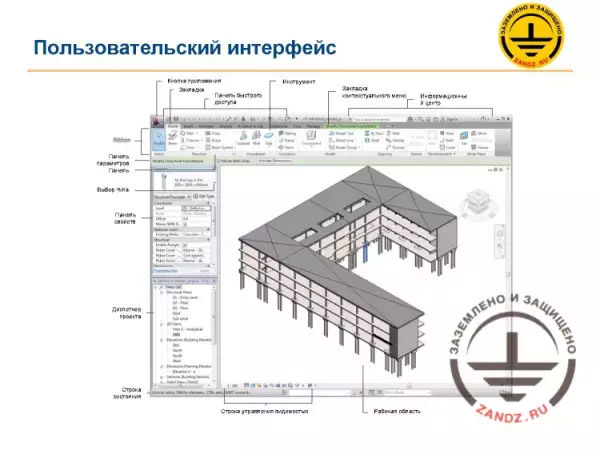 Webinar «Software structure and general concepts of revit», page 3
Webinar «Software structure and general concepts of revit», page 3
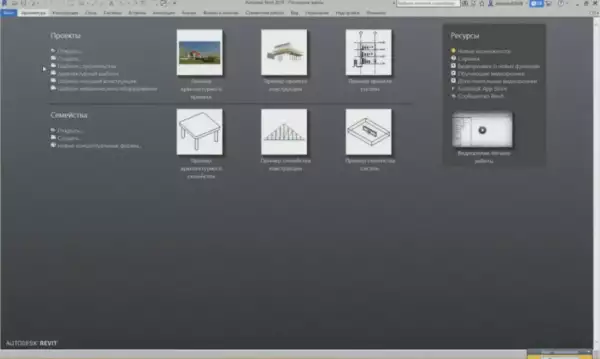 Webinar «BIM design in Revit. Getting started», page 1
Webinar «BIM design in Revit. Getting started», page 1
 Webinar «BIM design in Revit. Getting started», page 2
Webinar «BIM design in Revit. Getting started», page 2
 Webinar «BIM design in Revit. Getting started», page 3
Webinar «BIM design in Revit. Getting started», page 3




